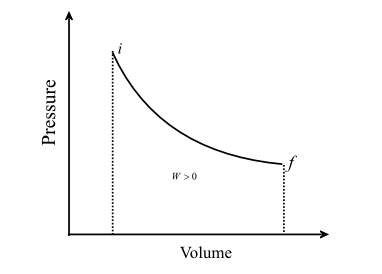
Find the work done by a gas when it expands isothermally at \[37^\circ {\text{C}}\] to four times its initial volume.
A \[3753\;{\text{J}}\;\]
B \[3573\;{\text{J}}\;\]
C \[7533\;{\text{J}}\;\]
D \[5375\;{\text{J}}\]
Answer
555.9k+ views
Hint:In this question, first draw the pressure vs volume curve of an isothermal process and discuss the work done by this process. Apply the condition of final volume and initial volume to find out the work done.
Complete step by step solution:
In this problem, the gas is expanding isothermally at $37^\circ {\text{C}}$ means the temperature remains constant and the volume of the gas changes four times the initial volume. We have to calculate the amount of force required to expand the gas.
Now, we consider the $p - v$ diagram of the Isothermal process as,

Let us assume \[{v_1}\] is initial volume and so according to the given condition and \[{v_2}\] Is the final volume.
Let \[W\] be the total work done, so for the isothermal process we can write
\[W{\text{ }} = {\text{ }}nRTln\dfrac{{{v_2}}}{{{v_1}}}\]
As we know, here the universal gas constant is $R$, the temperature of the process is $T$, and the number of moles is $n$
According to the given condition, we can write
\[{v_2}{\text{ }} = {\text{ }}4{v_1}\]
First we convert the unit of the temperature from $^\circ {\text{C}}$ to ${\text{Kelvin}}$ as,
$T = \left( {37^\circ {\text{C}} + 273} \right)\;{\text{K}}$
$ \Rightarrow T = 310\;{\text{K}}$
Now, we substitute the given values in the work done expression as,
\[W{\text{ }} = {\text{ }}\left( 1 \right)\left( {8.314} \right)\left( {310} \right){\text{ln}}\left( 4 \right)\]
After simplification we obtain,
$\therefore W = 3573\;{\text{J}}$
Thus, the work done by a gas when it expands isothermally at \[37^\circ {\text{C}}\] to four times its initial volume is \[3573\;{\text{J}}\].
Note: As we know that if the system is compressed by the surrounding, then the work done is negative and the internal energy of the system increases. And if the system expands, it will work on the surroundings and the internal energy of the system decreases.
Complete step by step solution:
In this problem, the gas is expanding isothermally at $37^\circ {\text{C}}$ means the temperature remains constant and the volume of the gas changes four times the initial volume. We have to calculate the amount of force required to expand the gas.
Now, we consider the $p - v$ diagram of the Isothermal process as,

Let us assume \[{v_1}\] is initial volume and so according to the given condition and \[{v_2}\] Is the final volume.
Let \[W\] be the total work done, so for the isothermal process we can write
\[W{\text{ }} = {\text{ }}nRTln\dfrac{{{v_2}}}{{{v_1}}}\]
As we know, here the universal gas constant is $R$, the temperature of the process is $T$, and the number of moles is $n$
According to the given condition, we can write
\[{v_2}{\text{ }} = {\text{ }}4{v_1}\]
First we convert the unit of the temperature from $^\circ {\text{C}}$ to ${\text{Kelvin}}$ as,
$T = \left( {37^\circ {\text{C}} + 273} \right)\;{\text{K}}$
$ \Rightarrow T = 310\;{\text{K}}$
Now, we substitute the given values in the work done expression as,
\[W{\text{ }} = {\text{ }}\left( 1 \right)\left( {8.314} \right)\left( {310} \right){\text{ln}}\left( 4 \right)\]
After simplification we obtain,
$\therefore W = 3573\;{\text{J}}$
Thus, the work done by a gas when it expands isothermally at \[37^\circ {\text{C}}\] to four times its initial volume is \[3573\;{\text{J}}\].
Note: As we know that if the system is compressed by the surrounding, then the work done is negative and the internal energy of the system increases. And if the system expands, it will work on the surroundings and the internal energy of the system decreases.
Recently Updated Pages
Why are manures considered better than fertilizers class 11 biology CBSE

Find the coordinates of the midpoint of the line segment class 11 maths CBSE

Distinguish between static friction limiting friction class 11 physics CBSE

The Chairman of the constituent Assembly was A Jawaharlal class 11 social science CBSE

The first National Commission on Labour NCL submitted class 11 social science CBSE

Number of all subshell of n + l 7 is A 4 B 5 C 6 D class 11 chemistry CBSE

Trending doubts
What is meant by exothermic and endothermic reactions class 11 chemistry CBSE

10 examples of friction in our daily life

One Metric ton is equal to kg A 10000 B 1000 C 100 class 11 physics CBSE

1 Quintal is equal to a 110 kg b 10 kg c 100kg d 1000 class 11 physics CBSE

Difference Between Prokaryotic Cells and Eukaryotic Cells

What are Quantum numbers Explain the quantum number class 11 chemistry CBSE




